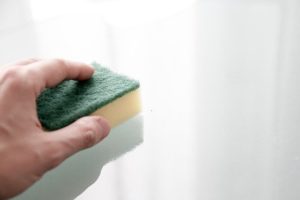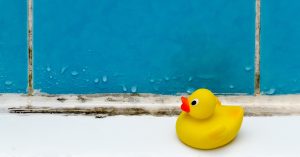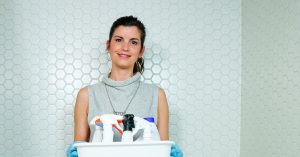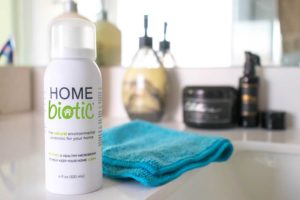Do Not Clean Mold With Bleach: Here’s Why

A fairly common experience for homeowners is to find a small patch of mold and immediately reach for some sort of antibacterial cleaner, namely bleach, to deal with the issue. But did you know, you shouldn’t clean mold with bleach? We know, this raises a whole host of questions about modern cleaning practices:
- But what if you’re cleaning your house all wrong?
- What if you’re making it easier for the spots of mold to take over?
- What if there is such a thing as too clean or too sterile?
Sadly, mold removal is never as simple as it looks on TV. But the good news is that it’s straightforward and safe to tackle small outbreaks of the mold without having to call in a professional – and without dealing with bleach fumes.
 Using Bleach To Clean Mold
Using Bleach To Clean Mold
We’ve all done it. Noticed a spot of mold in the shower, sprayed bleach then scrubbed away the discolored patch on the wall or grouting. That’s that.
Bleach works fantastically on tiling, and other hard surfaces, where moisture and humidity provide a friendly environment for mold. But bleach-based cleaners are not suitable for dealing with mold in the home, and, despite the convincing commercials, powerful antibacterial sprays that target black mold simply aren’t worth the money.
The truth: bleach is an excellent disinfectant, and fantastic at making everything look sparkling clean. A whitening appearance means that all the dirt and nasty stuff has gone, right? But appearances can be deceiving.
A common misconception is that mold behaves similarly to bacteria. While both live in colonies and are classified separately from plants or animals – mold is part of the fungal family, and bacteria are single-celled microorganisms1. Mold plays an important role in aiding the decomposition of dead matter in the wild and can be found in humid wet places2. Meanwhile, bacteria can be found all over our planet, in soil and water, inside plants and animals.
A common misconception is that mold behaves similarly to bacteria. While both live in colonies and are classified separately from plants or animals – mold is part of the fungal family, and bacteria are single-celled microorganisms Share on XTheir behaviors are distinctive – mold reproduces by releasing spores into the air, while bacteria generally only release spores when there is no alternative: they usually reproduce asexually. In the same way that mold and its function is not inherently bad, different bacteria strains have different purposes in the soil, in water, and in your gut microbiome – and these are just a few examples. Both bacteria and mold are important to the ecosystem, and so cannot be dismissed out of hand as bad. But they are not the same thing, so it seems odd that we attempt to clean them up with the same cleaning products.
 Why Is Bleach Bad For Cleaning Mold?
Why Is Bleach Bad For Cleaning Mold?
Bleach is an antibacterial product, often used for sterilization, normally with a chlorine base. Sodium hypochlorite is used in the production of liquid bleach. There are a handful of reasons that bleach is not the answer for cleaning mold:
Spores – Bleach is unable to kill off mold spores, which is their way of reproducing. Mold releases spores in order to create new colonies. Bleach can’t neutralize mold spores and mycotoxins, meaning they remain stuck to surfaces that are otherwise “sparkling clean”.
Porous Materials – Bleach is adequate for removing mold on non-porous materials such as work surfaces, sinks, hard plastic floors, tiles, and glass. However, on porous materials, bleach struggles to make an impact: killing the visible mold on surfaces such as wood, fabric, and drywall, but unable to reach the mold which remains underneath the surface ready to grow again3.
Available Mold Resources – Cellulose, the organic matter that feeds mold, can stop the bleach from fully sterilizing the area. Organic matter turns bleach inactive4.
Lack of Beneficial Bacteria – Bleach is an excellent antibacterial agent, but it works too well as a biocide, rendering places where it’s used completely sterile5. Not all bacteria are bad: some types of bacteria can do a lot of good, including the microbiome in your gut. Some bacteria in your home and in the wider world have the purpose of feasting on mold colonies. But if you kill off these friendly bacteria, you leave a vacuum where mold can flourish.
Not all bacteria are bad: some types of bacteria can do a lot of good, including the microbiome in your gut. Some bacteria in your home and in the wider world have the purpose of feasting on mold colonies. But if you kill off these… Share on XYou may find it difficult to wrap your head around this information, after years of mopping, scrubbing, and spraying mold with bleach. Bleach may still have a purpose – though here at Homebiotic, we’d argue that a sterile home should be very low on your list of priorities. There are many more health benefits to encouraging friendly bacteria in your home.
 What Kills Mold Spores?
What Kills Mold Spores?
Since using bleach is highly not recommended, what is a suitable alternative to not only kill mold spores but ensure your family remains protected from harmful chemicals? The good news is that mold only releases spores when it’s thriving, so your plan of action is simple:
- Cut the mold off from its creature comforts: Reduce the moisture and condensation in your home, and get your leaky roof and rickety plumbing sorted out once and for all6.
- Control the humidity in your home: Dehumidifier machines are great for this, but depending on the climate of where you live, simply cracking open the window can help.
- Use a HEPA filter vacuum cleaner: Frequently suck up any dust and mold spores that may be hiding in the carpets and upholstery. Mold spores can lie dormant for years7.
- For killing mold on porous surfaces, use borax (sodium borate): Wipe clean the surfaces using borax. Borax is not an antibacterial substance: instead, it changes the pH of the area you’re cleaning, making it inhospitable for mold.
- Additionally, you can use Homebiotic Surface Cleaner: It cleans surfaces naturally without harsh chemicals that damage your home and body biome. The Homebiotic Nano Sponge wipes away mold, dirt, and grime without cultivating harmful bacteria found in conventional sponges. Following up with the Homebiotic Probiotic Spray will re-introduce good bacteria into your home environment, which helps fight grime before it causes a problem.
- Stop using antibacterial products: The Homebiotic Probiotic Spray will reinstate friendly bacteria – to consume mold, and to protect the natural microbiome of your home.
References
https://www.ncbi.nlm.nih.gov/books/NBK8120/
https://www.cdc.gov/mold/faqs.htm
https://ir.library.oregonstate.edu/concern/articles/6969z1338?locale=en
https://www.ncbi.nlm.nih.gov/books/NBK214356/
https://www.epa.gov/sites/production/files/2016-10/documents/moldguide12.pdf
https://www.epa.gov/sites/production/files/2016-10/documents/moldguide12.pdf
https://pubs.ext.vt.edu/content/dam/pubs_ext_vt_edu/2901/2901-7019/2901-7019_pdf.pdf



 DOWNSIDES OF USING BLEACH
DOWNSIDES OF USING BLEACH IS HYDROGEN PEROXIDE BETTER?
IS HYDROGEN PEROXIDE BETTER?